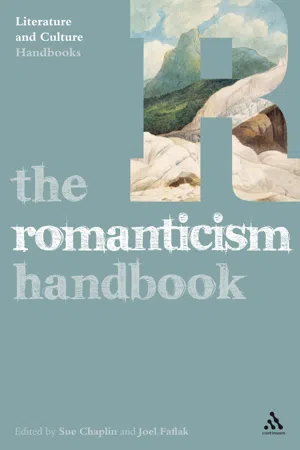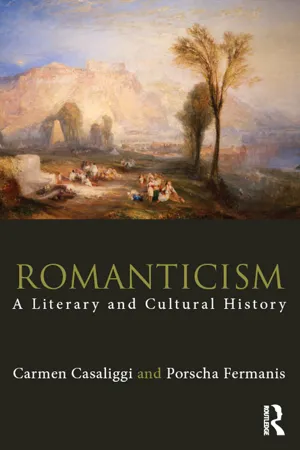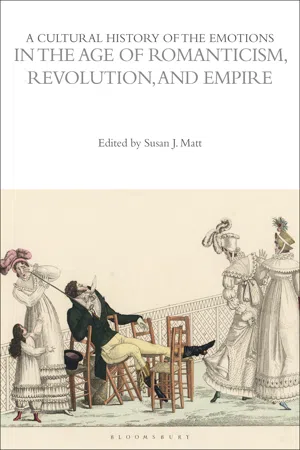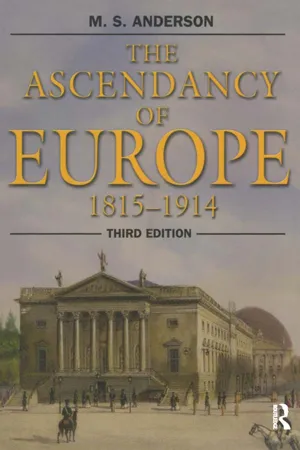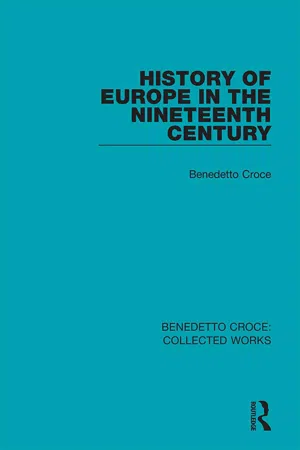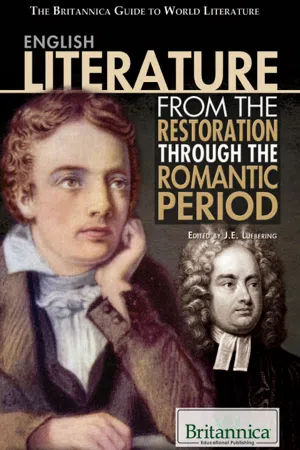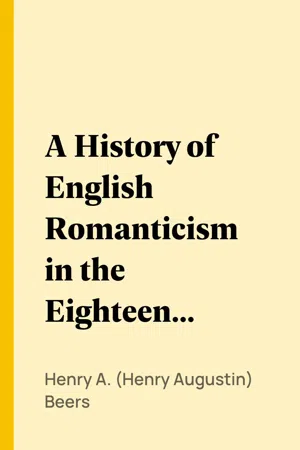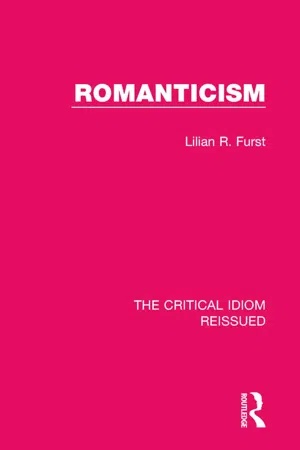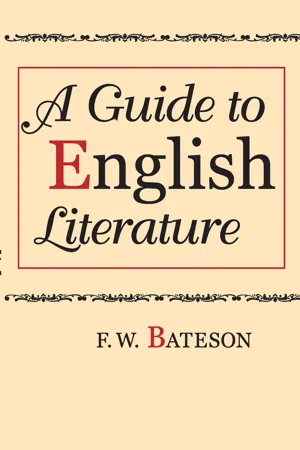Literature
Romanticism
Romanticism in literature was a movement that emerged in the late 18th century, emphasizing emotion, individualism, and the beauty of nature. It rejected the rationalism of the Enlightenment and sought to evoke strong emotions in readers through vivid imagery and passionate storytelling. Romantic literature often explored themes of love, heroism, and the supernatural, and it had a lasting impact on the development of literary expression.
Written by Perlego with AI-assistance
Related key terms
10 Key excerpts on "Romanticism"
- eBook - ePub
- Sue Chaplin, Joel Faflak, Sue Chaplin, Joel Faflak(Authors)
- 2011(Publication Date)
- Continuum(Publisher)
These are the parameters we shall follow for this Handbook, although we have extended the historical timeline at the end of this chapter back to 1776 to give our reader some sense of the historical, literary, and cultural framework from which British Romanticism emerges. If Romanticism can be difficult to periodize, it can also be difficult to conceptualize. This is not to say that Romanticism lacks defining characteristics or that we cannot apply these characteristics with some certainty to the period’s various literary achievements. But it is to say that one of these defining features is the fact that these features frequently contradict one another, and so paint the picture of a period often distinctly at odds with itself and its own desires, potentials and aims. The same could be said of any literary period, but seems distinctly apt when speaking of Romanticism and the idea of the Romantic. We need to ask, beginning with Romantic writers themselves, what factors were at stake when they set about self-fashioning their identities for their own and future audiences. One of the first usages of the word to define both an aesthetic practice and cultural movement is by the German philosopher and literary critic Friedrich Schlegel, leading figure of a group of intellectuals and artists who opposed both French politics and French thought. In his early writings Schlegel embraced the ancient, which was characterized by a kind of authentic striving towards the ideal, against the modern, about which there was something limited and strained (another German writer and philosopher, Friedrich Schiller, makes a similar distinction between the ‘naive’ and the ‘sentimental’). Yet gradually Schlegel embraced the Romantic as deeply expressive of something authentic about the time’s own nature. The word ‘Romantic’ had emerged by the early nineteenth century as a way of taking the pulse of the times, what the critic William Hazlitt in 1825 would call ‘the spirit of the age’ - eBook - ePub
Romanticism
A Literary and Cultural History
- Carmen Casaliggi, Porscha Fermanis(Authors)
- 2016(Publication Date)
- Routledge(Publisher)
part of a great endeavor to overcome the split between subject and object, the self and the world, the conscious and the unconscious. This is the central creed of the great Romantic poets in England, Germany and France. It is a closely coherent body of thought and feeling(Wellek 1963 : 220)Between 1945 and 1970 similarly recuperative attempts to define Romanticism as a cohesive aesthetic or cultural movement by critics such as Walter Jackson Bate, M. H. Abrams, Earl Wasserman, Northrop Frye, Carl Woodring, Geoffrey Hartman and Harold Bloom were less pan-European in their orientation but also tended to portray Romantic writers as ‘triumphantly internalizing their traumatic encounter with history and politics’ (Klancher 1989 : 79).Many of the orthodoxies or the most enduring ideas and popular perceptions of Romanticism emerged from the work of these critics in the post-war period: for example, the idea of Romantic poetry as an expression of emotion or feeling; the idea of the lyric poem as the movement’s representative form of expression; the idea of the creative and solitary Romantic genius; and the idea that the imaginative faculty allowed the poet to transcend the material world. In formulating this ‘interiority’ model of Romanticism very little attention was paid to Romantic-era dramas, novels and narrative poems, or to female, working-class, Irish, Scottish and Welsh writers. Nor were the historical, material and intellectual contexts in which Romantic writers lived and worked a primary site of investigation. As Ian Duncan has put it, Romanticism was for many years solidified in the university system as ‘an ideologically potent account of lyric poetry … which escaped or resisted the collected pressures of society and history’ (Duncan 2004: 5 ).The most serious challenge to this understanding of Romanticism came in the 1980s in the form of works such asMarilyn Butler’s Romantics, Rebels and Reactionaries (1981)andJerome McGann’s The Romantic Ideology (1983). McGann pointed out that both Romantic writing and its scholarship were ‘dominated … by an uncritical absorption in Romanticism’s own self-representations’ (McGann 1983: 137 ), accusing Abrams, Wellek and others of perpetuating the myths about genius, originality and isolationism that Romantic writers told about themselves (see also Siskin 1988 ). McGann also pointed to the tension between two central approaches to Romanticism, the first of which sees it as an aesthetic movement, and the second as a historical phenomenon or distinct historical period. As he later noted, the distinction between ‘Romanticism’ and the ‘Romantic period’ is ‘important not merely because so much of the work of [the] period is not “romantic”, but even more, perhaps, because the period is noted for its many ideological struggles … [and] sharp cultural conflict; some of the fiercest engagements were internecine – the civil wars of the romantic movement itself’ (McGann 2002 - Susan J. Matt, Susan J. Matt(Authors)
- 2020(Publication Date)
- Bloomsbury Academic(Publisher)
Meister” (1798), the German writer Friedrich Schlegel defined the reader’s experience in terms of powerful and unscripted emotional responses to the text:It is a beautiful and indeed necessary experience when reading a poetic work to give ourselves up entirely to its influence, to let the writer do with us what he will; perhaps only in matters of detail is it necessary to pause and confirm our emotional response with a moment’s reflection, raise it into a thought, and where there is room for doubt or dispute, decide and amplify the matter. This is the prime, the most essential response.—Schlegel 1991: 273While emotion remains central to the competing definitions of Romanticism, the period is also often characterized in terms of its revolutionary qualities and its break with what came before (Butler 1992; Paulson 1983). The era’s ideas and writings are often starkly contrasted with those of the preceding era “in terms of binary oppositions, such as reason versus emotion; objectivity versus subjectivity; spontaneity versus control; limitation versus aspiration; empiricism versus transcendentalism; society versus the individual; public versus private; order versus rebellion; the cosmopolitan versus the national, and so on” (Kitson 1998: 35).Nevertheless, recent literary historical work on Romantic literature has altered our understanding of the shift from the Age of Sensibility to Romanticism. Indeed, the new consensus might be that “Romanticism absorbs rather than supersedes or decisively breaks with Enlightenment culture” (Yousef 2013: 3). In the wake of the American and French revolutions, and in the disappointments and hopes and horrors that followed both, the representation of emotion in Western literatures underwent identifiable transformations. Janet Todd, for example, sees post-Revolutionary British literature as affectively more subdued and more likely to highlight “qualities considered peculiarly British, such as restraint, self-control and stoical, wry acceptance” (Todd 1986: 131; Ablow 1991: 195). Nevertheless, the ongoing influence of sentimental literature is striking, and the changes wrought by Romanticism may be subtler and more nuanced than once imagined.- eBook - ePub
The Ascendancy of Europe
1815-1914
- M.S. Anderson(Author)
- 2014(Publication Date)
- Routledge(Publisher)
In every aspect of intellectual and cultural life – in the physical sciences, in music and the arts, in thinking about politics and society – the nineteenth and early twentieth centuries were a more complex age, more dynamic, more varied, more rapidly and incessantly changing, than any preceding one. To summarize it is therefore to falsify, perhaps even seriously to falsify. Yet if a summary is to be attempted much of its life can be grouped under one or another of the great tides of thought and feeling mentioned in the title of this chapter. In the first half of the nineteenth century the triumph of Romanticism was never complete. Yet that period gave freer play than ever before to fundamental emotional drives and appetites which the eighteenth-century Enlightenment had tended to neglect and which have remained a great force in European life ever since. In the later decades of the century evolutionary ideas, in the widest sense of the term, revolutionized thinking about the nature and purpose of human life and seemed to open to it a whole new vista of possibilities. From the 1890s onwards the most original thinkers tended to concentrate their efforts more and more on the mysteries and irrationalities of man’s nature and to see the problems of man in society in a new light, in terms of consciousness rather than in those of mechanism or even ideas. Throughout these wonderfully productive generations change, by the standards of the past sometimes almost apocalyptic in its violence and suddenness, was building up a mental climate very different from that of the eighteenth century. Political hopes and fears, artistic dogmas, pessimism about the way the world was going and messianic hopes of a future unlike anything hitherto known – all were now more intense and more widespread than ever in the past. The marvellous intellectual and artistic fecundity of the period was both the measure and the outcome of its tensions and dilemmas.Romanticism is one of the vaguest of the many vague terms in the vocabulary of the historian. It is scarcely possible to find any characteristic shared by all the romantics of the first half of the nineteenth century, or to draw up any confession of faith to which they would all have subscribed. Nevertheless the word is not meaningless: it is possible to make a number of general statements about Romanticism which are as well grounded as most generalizations. It meant most fundamentally of all a stressing of the individual, of his potentialities, of his autonomy as against society or any group within society, of the value of his feelings, spontaneous and unforced, as the yardstick against which the world must be measured. This meant that it erected against the ideals of moderation and elegance which had dominated much of the eighteenth century the new one of the exceptional spirit leading, and entitled to lead, the mediocrities by whom he inevitably found himself surrounded. Such a spirit, as an English painter convinced of his own genius put it, was ‘sent into the world not to obey laws but to give them’.1 This ideal was a deeply anti-egalitarian one. Allied with the Rousseauist belief that the emotions, especially those of love and grief, were felt more intensely and with greater purity by a minority of beaux esprits - eBook - ePub
- Benedetto Croce(Author)
- 2019(Publication Date)
- Routledge(Publisher)
III. THE ROMANTIC MOVEMENTC ONTEMPORARY with the rise and growth of idealism and liberalism, and often in the same individuals, was the birth and expansion of Romanticism; a simultaneity that is not a mere juxtaposition, but a relation or a multiplicity of relations, as it will be advisable to make clear and to keep in mind.To this end it is necessary, first of all, to emphasize a distinction that has almost always been lost sight of by those (and they have been of late years and still are many) who talk of Romanticism and write histories of it. Without this distinction it is inevitable that certain spiritual manifestations of a positive character fall, as it were, under a cloud of disapproval, and others of a negative character are illumined in a favourable light, so that the history one sets out to write comes forth contradictory and confused. The distinction is between Romanticism in the theoretic and speculative sense and Romanticism in the practical, sentimental, and moral field: these are two diverse and even opposite things to one who does not wish to limit himself to the surface and to appearances.Theoretic and speculative Romanticism is the revolt, the criticism, and the attack against literary academicism and philosophic intellectualism, which had dominated in the illuminist age. It awakened the feeling for genuine and great poetry, and set forth the doctrine thereof in the new science of the imagination called aesthetics. It realized the great importance of spontaneity, passion, individuality, and gave them their place in ethics. It knew and made known the right of what exists and operates in all its varieties according to time and place, and founded modern historiography, interpreting it no longer as mockery and derision of past ages, but as understanding of these as parts of the present and of the future. And it reintegrated and retouched all the aspects of history, civil and political history no less than religious, speculative, and artistic. It thrust back into their natural limits the natural and mathematical sciences and their correlative mental form, showing that, outside of their own field, they were impotent to resolve the antinomies with which the mind came into conflict no less than those which had to remain in abstractions and separations. It grasped life in its active and combative sense, and thus prepared the theoretical premises of liberalism. Even in its irrationalistic concepts, as in the primacy sometimes allotted to emotion and mystic ecstasy, there was a justified polemic against abstract intellectualism, and, in irrational and provisional form, a nucleus of rational truth. Even in its mistaken attempts, as in those of a philosophy of history over and above all histories and of a philosophy of nature over and above all the natural sciences, there was visible the activity of the profound necessities of a history that should be at the same time a philosophy and of a nature understood both as such and as development and historicity, and recognized again as such either beyond or at the bottom of the classifications and the conventions with which and on which the scientist properly so called is obliged to work. In short, this Romanticism is not only in no wise in disagreement with modern philosophy, whether you choose to call that idealism or absolute spiritualism, but it is that philosophy itself, or certain particular doctrines of that philosophy, and therefore a duplicate appellative with its correlative double meanings and verbal paradoxes, as when the philosophy that goes from Kant to Hegel is called the “philosophy of Romanticism” and then “classic idealism”—therefore at the same time “romantic” and “classic.” - Josephine Guy, Ian Small(Authors)
- 2010(Publication Date)
- Routledge(Publisher)
Chapter 7 . The remainder of the present chapter will concentrate on the first understanding of context, exploring the complexities of the relationship between literature and its historical situation by reference to a number of specific but contested examples: the social reference (and thus the politics) of some Romantic period writing, of social-problem novels of the 1840s and 1850s and finally of society comedy in the 1890s. In each case, we will try to show the effect of different ways of defining a historical context on the interpretation and evaluation of particular works.The contexts of Romanticism
A traditional way of defining Romanticism, one which was responsible for producing the familiar all-male canon of Blake, Wordsworth, Coleridge, Byron, Shelley and Keats, was that popularised by M. H. Abrams in his seminal study The Mirror and the Lamp (1953). Abrams located Romanticism within the context of a history of ideas about literary representation. More precisely, and to develop the title of Abrams’s study, he defined its distinctiveness in terms of the way eighteenth-century neo-classical mimetic (or imitative) theories of art were superseded by an expressive aesthetic, one in which the value of poetry is held to reside in the uniqueness of the individual poet’s ‘vision’, in his (for Abrams was principally concerned with male poets) ability to articulate that vision, and where the human mind becomes an active agent in the formation of knowledge through a special kind of mental faculty – the faculty that the Romantics called the ‘imagination’. It is the operation of the imagination which gives poetry its privileged epistemological status: an ability, as Wordsworth phrases it in ‘Tintern Abbey’, to ‘see into the life of things’. The idealist concept of knowledge which underlies this revolutionary Romantic poetics can also be located in relation to contemporary philosophical debates. Of central importance is the opposition between the rationalism of the English philosopher John Locke (1632–1704), in which the mind is assumed originally to be a tabula rasa or blank sheet and in which all knowledge is held to be the product of experience, and the arguments of the German philosopher Immanuel Kant (1724–1804), that there exist transcendental structures within the mind which enable us to make sense of our experiences and which shape our knowledge of the world, while at the same time being themselves beyond the reach of human knowledge. In this view, the radicalism of Romanticism emerges in an opposition not simply to neo-classical ideas about the poet as a craftsman or maker, but also to certain values associated with the Enlightenment, such as the empiricism that had come (and would continue) to dominate contemporary scientific enquiry. In Blake’s enigmatic words in The Marriage of Heaven and Hell- Britannica Educational Publishing, J.E. Luebering(Authors)
- 2010(Publication Date)
- Britannica Educational Publishing(Publisher)
CHAPTER 3 THE ROMANTIC PERIOD A s a term to cover the most distinctive writers who flourished in the last years of the 18th century and the first decades of the 19th, Romantic is indispensable but also a little misleading. There was no self-styled “Romantic movement” at the time, and the great writers of the period did not call themselves Romantics. Not until August Wilhelm von Schlegel’s Vienna lectures of 1808–09 was a clear distinction established between the “organic,” “plastic” qualities of Romantic art and the “mechanical” character of Classicism. Many of the age’s foremost writers thought that something new was happening in world affairs, nevertheless. William Blake’s affirmation in 1793 that “a new heaven is begun” was matched a generation later by Percy Bysshe Shelley’s “The world’s great age begins anew.” “These, these will give the world another heart, / And other pulses,” wrote John Keats, referring to Leigh Hunt and William Wordsworth. Fresh ideals came to the fore, in particular, that freedom was being extended to every range of human endeavour. As that ideal swept through Europe, it became natural to believe the age of tyrants might soon end. POETRY The most notable feature of the poetry of the time is the new role of individual thought and personal feeling. Where the main trend of 18th-century poetics had been to praise the general, to see the poet as a spokesman of society addressing a cultivated and homogeneous audience, and having as his end the conveyance of “truth,” the Romantics found the source of poetry in the particular, unique experience. Blake’s marginal comment on Sir Joshua Reynolds’s Discourses expresses the position with characteristic vehemence: “To Generalize is to be an Idiot. To Particularize is the alone Distinction of Merit.” The poet was seen as an individual distinguished from his fellows by the intensity of his perceptions, taking as his basic subject matter the workings of his own mind- Henry A. (Henry Augustin) Beers(Author)
- 2005(Publication Date)
- Perlego(Publisher)
I. The Subject Defined II. The Augustans III. The Spenserians IV. The Landscape Poets V. The Miltonic Group VI. The School of Warton VII. The Gothic Revival VIII. Percy and the Ballads IX. Ossian X. Thomas Chatterton XI. The German TributaryA HISTORY OF ENGLISH Romanticism
CHAPTER I.
The Subject DefinedTo attempt at the outset a rigid definition of the word Romanticism would be to anticipate the substance of this volume. To furnish an answer to the question—What is, or was, Romanticism? or, at least, What is, or was English Romanticism?—is one of my main purposes herein, and the reader will be invited to examine a good many literary documents, and to do a certain amount of thinking, before he can form for himself any full and clear notion of the thing. Even then he will hardly find himself prepared to give a dictionary definition or Romanticism. There are words which connote so much, which take up into themselves so much of the history of the human mind, that any compendious explanation of their meaning—any definition which is not, at the same time, a rather extended description—must serve little other end than to supply a convenient mark of identification. How can we define in a sentence words like renaissance, philistine, sentimentalism, transcendental, Bohemia, pre-Raphaelite, impressionist, realistic? Definitio est negatio. It may be possible to hit upon a form of words which will mark Romanticism off from everything else—tell in a clause what it is not; but to add a positive content to the definition—to tell what Romanticism is, will require a very different and more gradual process.[1]Nevertheless a rough, working definition may be useful to start with. Romanticism, then, in the sense in which I shall commonly employ the word, means the reproduction in modern art or literature of the life and thought of the Middle Ages. Some other elements will have to be added to this definition, and some modifications of it will suggest themselves from time to time. It is provisional, tentative, classic, but will serve our turn till we are ready to substitute a better. It is the definition which Heine gives in his brilliant little book on the Romantic School in Germany.[2] "All the poetry of the Middle Ages," he adds, "has a certain definite character, through which it differs from the poetry of the Greeks and Romans. In reference to this difference, the former is called Romantic, the latter Classic. These names, however, are misleading, and have hitherto caused the most vexatious confusion."[3]- eBook - ePub
- Lilian R. Furst(Author)
- 2017(Publication Date)
- Routledge(Publisher)
2The pre-history of the Romantic movementThe roots of the Romantic movement lie in the eighteenth century in a series of interlocking trends of cumulative effect: the decline of the Neo-classical system led to the questionings of the Enlightenment, which in turn was conducive to the infiltration of the new notions current in the latter half of the century. Although the appellation ‘pre-Romantic’ is generally reserved for certain writers and thinkers who were direct forerunners of the Romantics in ideas or style (e.g. Rousseau, Young, Macpherson, Bernardin de Saint-Pierre), in a wider sense the term is appropriate to the entire line of development in the eighteenth century, in so far as it paved the way for the crystallization of the Romantic movement. A major reorientation of critical standards and methods was an essential pre-condition for the blossoming of Romanticism, and this took place in the course of the eighteenth century. Thus the Romantic movement, though it effected a literary revolution at its decisive break-through, was in itself in fact the product of a protracted process of evolution. The direction and form of this evolution points to the nature of the Romantic revolution.The decline of the Neo-classical systemThe period that equated ‘romantic’ with ‘chimerical’ and ‘ridiculous’ was that of Neo-classicism, which was at its height in the seventeenth century, notably in France. Since the revival of Classical standards in the Renaissance, the main concern had been the establishment, elaboration and spread of a view of literature inherited from Greek and Roman antiquity. The chief sources of aesthetic ideas were, for over two centuries, Aristotle, Horace, Quintilian and Longinus. The major topic of discussion was the revival and imitation of the Ancients, who enjoyed unlimited authority and inspired a strong craving to conform to their patterns. This is most evident in France, where the Neo-classical attitude was codified by critics as powerful as Boileau and where the strict observance of the three unities was considered of paramount importance. Moreover, the passage of time brought an increasing emphasis on a merely repetitive formalism, a hollow clinging to the outer practices of Neo-classicism without any deeper understanding of its aims such as had inspired the great poets of the seventeenth century. This dogmatism was buttressed in France by the dominance of an absolute monarchy allied to the Catholic Church so that the literary as well as the political and religious regime was close to totalitarianism. In the England of parliamentary rule and easy-going Protestantism there was never the same degree of conformity; the approach to both political organization and literary taste was far more flexible, not to say unsystematic, partly no doubt as a result of Shakespeare’s disregard of the Neo-classical canons. It is, nevertheless, worth recalling that the early eighteenth century could and did dismiss Hamlet - eBook - ePub
- F. W. Bateson(Author)
- 2017(Publication Date)
- Routledge(Publisher)
4. The Retreat From RomanticismIn a recent article in the Journal of Aesthetics, Romanticism was defined, correctly, as “the tendency to break the confines, the rules, the limits, to go beyond that which has been crystallized”.11 As opposed to the Classic, then, with its trend to a norm or mean, the Romantic is essentially antinomian and extremist. Like nationalism and capitalism, its political and economic counterparts, Romanticism’s mstinct is to absorb or enslave whatever it may encounter other than itself. The eighteenth century had been an age that relied on checks and balances, not only in constitution-building and foreign policy, but equally in its favorite verse form (the heroic couplet) and its prose style (the balanced clause). With the coming of Romanticism the Augustan balance of opposites is succeeded in Coleridge’s formula by what he called the “fusion” of discordant elements. The Ego, instead of being in equipoise with the Non-Ego, now tries to assimilate all phenomena external to itself, as the nation-state asserts its identity by conquering its neighbors. A similar refusal to compromise operated in science and in religion. As between these two rival absolutes science would not allow the truths of religion even a metaphoric validity, to which religion, in the person of Newman, reacted by raising atoms to angels—a “beautiful prospect” was the product of angelic robes, and every flower, herb, and pebble “some powerful being who was hidden behind the visible things he was inspecting.”12Nevertheless, in spite of these appearances to the contrary, nineteenth-century individualism did contain within itself its own limiting principle. An individual cannot rebel unless there is a society of which he has been a member to rebel against. You cannot break confines, rules, and limits unless they have been previously crystallized. Subjectivism implies and indeed requires an objective universe on which, to use one of Wordsworth’s favorite metaphors for expressing the relationship, it can “feed.”13
Index pages curate the most relevant extracts from our library of academic textbooks. They’ve been created using an in-house natural language model (NLM), each adding context and meaning to key research topics.
